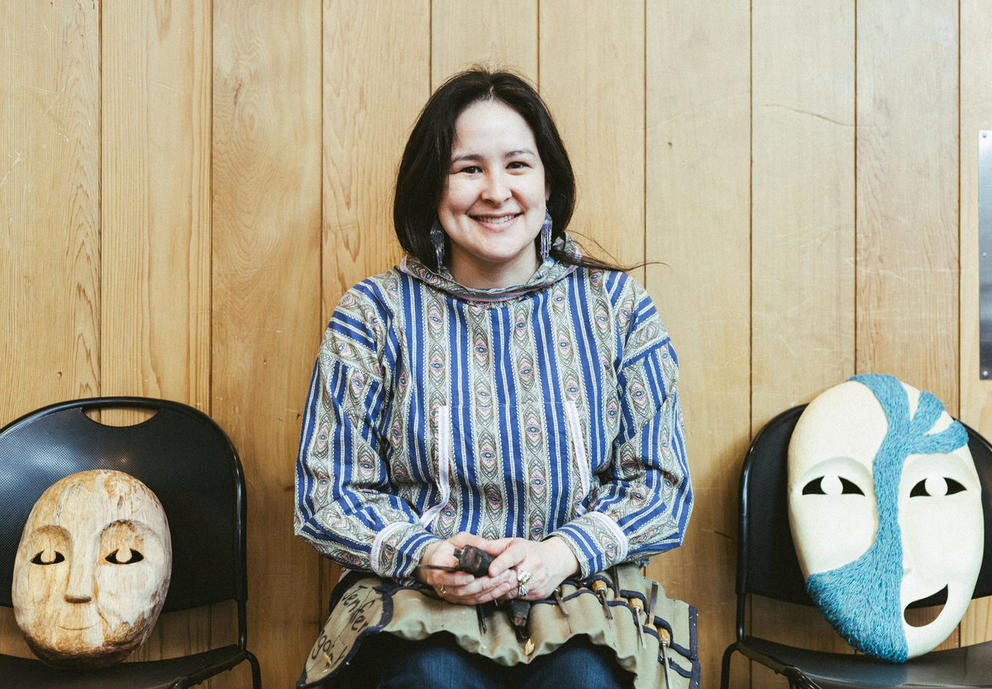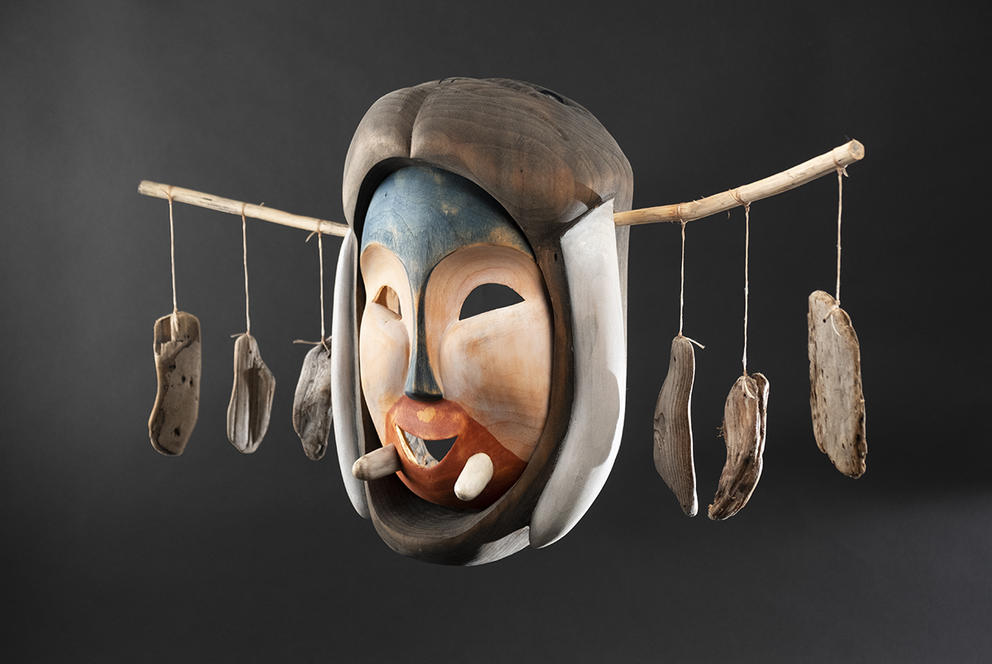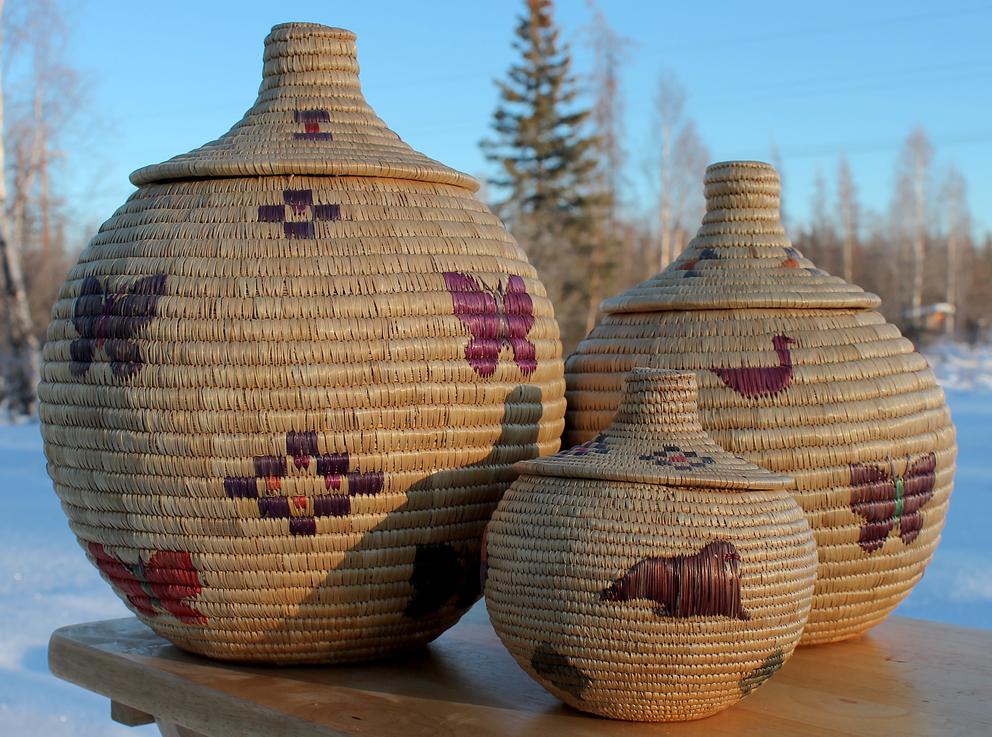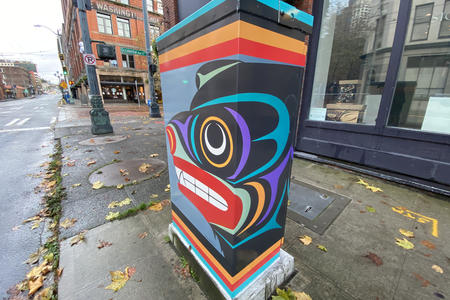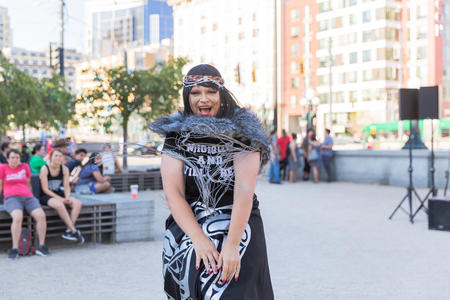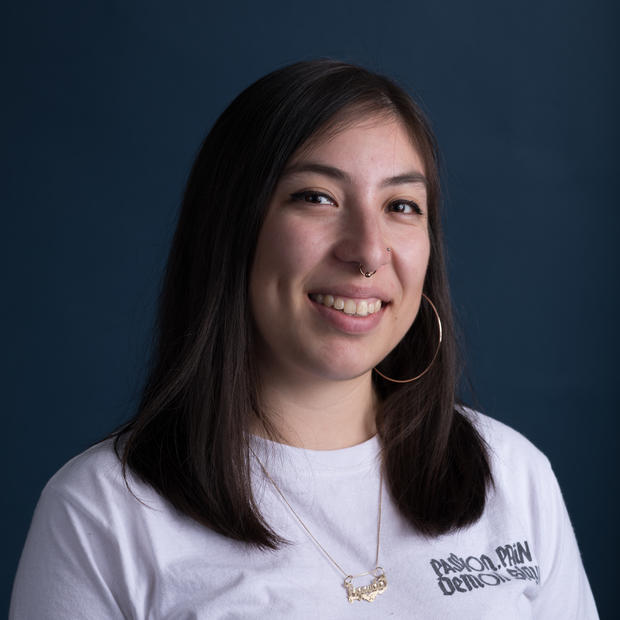Manook was such an influence that when he died suddenly in 1999, Wood stopped carving. But in 2007, he urged her to “get back to work” — by way of a dream. The day after, Wood woke up, bought some basswood (favored by carvers for its pliability) and “got to it.” She hasn’t stopped since.
In her carving process, Wood says she looks to the past for inspiration and listens and responds to the materials. Take her “Walrus Grandmother” mask, recently on view at Stonington Gallery in a show highlighting Alaska Native artists. Wood had carved a piece of green alder wood, intending to use it for a mask, but after drying, it nearly split. She hollowed out the center, leaving just a frame. Two years later, after seeing photos of a Yup'ik mask recently unearthed from an archaeological dig, she had an idea. Wood carved a smiling mask and positioned it inside the old alder wood border, which became a yawning walrus mouth. The mask peeking out from between the tusks happened to resemble Wood’s grandmother, hence the name.
Historically, Yup'ik carvers made masks to commemorate people and stories, and for spiritual ceremonies. Tribal shamans sometimes guided mask making in accordance with visions they had.
Wood, who moved to Indianola in Kitsap County five years ago, is continuing the ancestral tradition, but is also creating new customs. She adds contemporary elements, using bold colors and nontraditional materials, such as stained glass, wire and Swarovski crystals. She has carved a mask from a longboard skateboard deck in homage to spawning salmon, and another that honors the LGBTQ community with a swirl of rainbow colors, and another depicting “the feeling when you really want to laugh at something but you can’t.”
Wood was recently chosen for the inaugural Pacific Northwest arts fellowship for Indigenous artists offered by Nia Tero, a nonprofit organization supporting Indigenous communities. She’s also one of eight recipients of the 2020 McMillen Artist Community Fellowship from the Robert B. McMillen Foundation. Currently, she’s creating a series of large-scale masks in cast bronze, metal and glass for the new Washington State Convention Center. And next up, she’ll exhibit more masks in the group show Skyward, opening Dec. 1 at Stonington Gallery.
Crosscut spoke with Wood about how the pandemic has changed the way she thinks about masks and the importance she places on making traditional art contemporary.
This interview has been edited for length and clarity.
What draws you to mask making?
It's become a really important way for me to reconnect with my heritage. I feel really lucky I got to spend summers when I was a kid in Tununak [Alaska], which is my dad's home village. No one in my immediate family was a carver. My grandma used to make grass baskets, but there weren't any carvers. It's been a way for me to have this connection with materiality of the spirit practices of my ancestors and family.
How do Yup'ik masks differ from other Native mask traditions?
One of the biggest differences, especially in terms of Coast Salish work and formline design, which people are more familiar with around here, is that there's almost no symmetry in Yup'ik masks. So if you see a formline design mask with ovoids and “U”s and all those shapes, there's a certain way that those shapes are supposed to go together. [In] art from this area, symmetry is a very important element of the design.
In my dad's region, there are no large trees. [Given that], it seems unusual that carving was such a big tradition in that area, but every spring, storms would bring driftwood onto the beach. In Yup'ik masks, the shape was partly dictated by the piece of driftwood that the carver was working with, but also the purpose of the mask.
What traditions are behind Yup'ik masks?
There were different ceremonies during the winter time. There might be portrait masks, where they're telling the story about someone, or masks that would be used for certain religious purposes. So a shaman would have a vision or have a ceremony that they were supposed to do, and they would carve it or they would tell the carver what they wanted. Sometimes masks were just for fun.
A lot of Yup'ik masks have rings around them … “universe rings.” That represents our place in the universe, and in the human world in connection with the animal world and the spirit world, as well. If the mask is about hunting, there would be things like hands with holes in them because that represented allowing an animal spirit to continue on into the spirit world.
How do your masks keep the cultural tradition alive?
For me the goal is to preserve the overall purpose and aesthetic of masks. I have some masks that you can very clearly see the [historical] mask that I used for inspiration. I always try to keep in mind these masks were originally carved for very specific purposes and times. So I'll use the overall concepts or imagery or shapes, but I always try to adjust them and change them somehow, so I'm not tapping into the original spiritual purpose.
In what ways are you breaking with tradition, and why?
One of the challenges for a lot of Indigenous artists is to not be stuck in the past all the time from the outside viewer. I've been told: “You should focus more on traditional work because I liked that.” I view that as people telling me I should know my place and my place isn’t here-and-now, it's back then, like we're expected to not change. I completely, entirely reject that idea.
I'm trying to emphasize the fact that Native people are contemporary people. It is important for me to explore other materials that are referred to as nontraditional, using materials that are clearly modern. I just finished a piece where there's a mask in the center, but surrounding it is a glass mosaic. I'll use glass, beads, metal and found objects. Traditional historic work is really important because we need to preserve those elements of our cultures, but I also think it's very important to make it really clear that we're not just historical people.

Masks have a whole new meaning and prevalence due to COVID. How does your art relate to the masks we’re all wearing daily?
I had artist’s block in the earlier part of the year. What got me out of that slump was creating a mask mimicking an N95 mask. That is the kind of mask I use when I'm sanding my pieces. It was this weird moment of realizing that something that I took for granted had high priority for first responders, doctors, nurses, ambulance drivers.
I am also fascinated by this idea that we all wear figurative masks of some sort to present ourselves a certain way. Our lives have become defined by literal masks when we're out in public. Most people just want to be seen, but everything about living through a pandemic prevents that. And part of that is examining the [figurative] masks we wear everyday and trying to decide if they're worth keeping. Some people will gladly go back to them once life "returns to normal," but I think a lot of people will decide to set them aside, at least for a while, and see what comes of it.
If you had to pick one artwork that encapsulates 2020, what would it be and why?
The last like six months I've been listening to two albums by Muse: Absolution and The Resistance. Those themes are running through every single aspect of our lives right now: standing up and trying to do what's right. People are reckoning not only with society, but also who they are as people versus who they thought they were. That goes back to the mask conversation. The other [artwork] that really stands out is that huge, yellow Black Lives Matter mural along Pennsylvania Avenue leading up to the White House in D.C. It was such a bold statement.
What art or cultural object in your home have you found to be grounding during the pandemic?
I have a setup with grass baskets my grandma made, as well as a couple other grass baskets I’ve collected. It's really comforting to have them over my shoulder all the time — this tangible connection to history — because all of these items were used. They weren't just made for show.
My grandparents’ generation were babies in the 1918 pandemic. That time in rural Alaska is when people stopped believing in shamans, because not only could the shamans not heal people anymore, they were also dying of this new disease. When I look at these items, I think about that time and the fact that people just continued on. They did what they needed to do, and they just kept going. [It] reminds me that we've been through this before. Unfortunately, [during COVID-19] a lot of Native communities are losing elders, the knowledge bearers of their communities. They're going to have a lot of rebuilding to do once this is over.
What do you think people misunderstand about Native arts?
One of the biggest things is that art was an integrated part of our lives. When Native artists produce today, we’re coming from that history where art wasn't just this fluffy extra. It was a really important part of our everyday existence, and part of that everyday existence is with our spiritual existence, our relationship with the land around us, with the animal world.
There is also a lot of misunderstanding about how many different tribes and forms of expression there are throughout the U.S. and of course throughout all of the Americas. There are 573 federally recognized tribes in the U.S., with several more hundred that are state-recognized and/or seeking federal recognition, and within each of those tribes there are many forms of expression. People tend to simplify their expectations of Native art, when in reality there are as many ways to express ideas and beliefs as there are Indigenous-identifying people.
Get the latest in local arts and culture
This weekly newsletter brings arts news and cultural events straight to your inbox.

